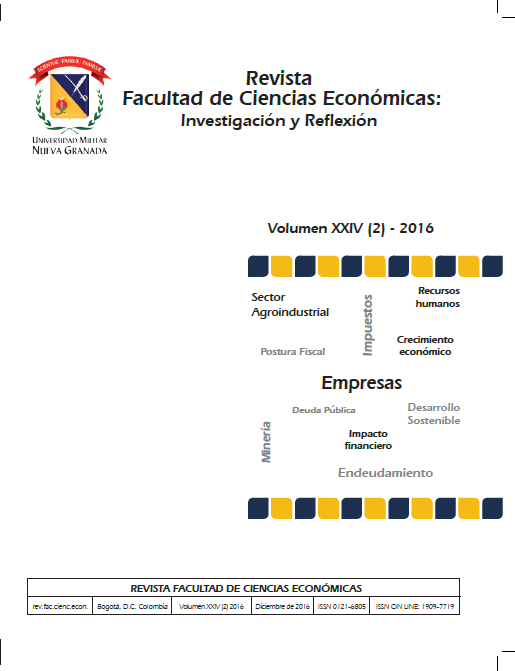Taxes and public debt: a paradoxical relationship
Abstract
This paper shows that an increase in debt aimed at reducing taxes may increase it in the long run. This occurs whenever a tax increase reduces the expectation of savings in an amount greater than public debt decreased initially. The reason why the debt grows is because the tax increase reduces investment and this has two effects: (i) decreases the production level, which causes a decrease in the tax base, i.e., meaning the government income; (ii) the interest rate increases and thus the cost of past debt. Against this background, the government is forced to increase public debt to maintain constant spending. In this paper, statistical evidence is offered for five European countries in crisis that shows that public debt is explained by the investment, as it results in the theoretical model; this suggests that the austerity policies implemented in these countries in order to reduce debt, may be counterproductive.Downloads
References
Alesina, A. & Ardagna, S. (2010). Large Changes in Fiscal Policy: Taxes Versus Spending. Tax Policy and the Economy, 24. http://dx.doi.org/10.1086/649828
Alesina, A. & Perotti, R. (1995). Fiscal Expansions and Fiscal Adjustments in OECD Countries. Economic Policy, 10 (21), 205–248. http://dx.doi.org/10.2307/1344590
Arellano, M., & Bond, S. (1988). Dynamic Panel Data Estimation Using PPD: A Guide for Users. Institute for Fiscal Studies (IFS) Working Paper Series.
Arellano, M., & Bond, S. (1991). Some Tests of Specification for Panel Data: Monte Carlo Evidence and an Application to Employment Equation. Review of Economic Studies, (58), 277-297. http://dx.doi.org/10.2307/2297968
Arellano, M., & Bover, O. (1990). La Econometría de Datos de Panel. Investigaciones Económicas (Segunda Época) XIV (1), 3-45.
Argando-a, A., Gámez, C., & Mochón, F. (1996) Macroeconomía Avanzada. I y II, Espa-a, Mc Graw Hill.
Barro, R. (1989). The Ricardian Approach to Budget Deficits. Journal of Economics Perspectives, 3 (2), 37-54. http://dx.doi.org/10.1257/jep.3.2.37
Baxter, M., & King, R. (1993). Fiscal Policy in General Equilibrium. American Economic Review, 83, 315-334
Benigno, P. (2015). New-Keynesian Economics: An AS–AD View. Research in Economics, 69 (4), 503-524. http://dx.doi.org/10.1016/j.rie.2015.07.005
Blanchard, O. & Leigh, D. (2013). Growth Forecast Errors and Fiscal Multipliers, National Bureau of Economic Research, (w18779).
Clower, R. (1965). The Keynesian Counter-Revolution: A Theoretical Appraisal. En: Hahn, F. & Brechling, F. (eds) The Theory of Interest Rate, Londres, Macmillan
Debreu, G. (1973). Teoría del Valor, Espa-a, Antoni Bosch.
Díaz, A. (2015). Crisis de la Zona Euro: Fallas Estructurales y Políticas de Austeridad. Economía UNAM, 13 (35), 45-68.
Guajardo, J., Leigh, D. & Pescatori, A. (2014) Expansionary Austerity? International Evidence. Journal of the European Economic Association, 12 (4), 949-968. http://dx.doi.org/10.1111/jeea.12083
Harrod, R. (1939). An Essay in Dynamic Theory. Economic Journal, 49. En: Sen, A. (1979). Lecturas: Economía del crecimiento, México, Fondo de Cultura Económica.
Heider, F. & Ljungqvist, A. (2012). As certain as debt and taxes: Estimating the tax sensitivity of leverage from exogenous state tax changes. National Bureau of Economic Research, (w18263), 1-55. http://dx.doi.org/10.2139/ssrn.2024200
Herndon, T., Ash, M. & Pollin, R. (2014). Does High Public Debt Consistently Stifle Economic Growth? A Critique of Reinhart and Rogoff. Cambridge Journal of Economics, 38(2), 257-279. http://dx.doi.org/10.1093/cje/bet075
Keynes, J. (1936). Teoría General de la Ocupación el Interés y el Dinero. México D.F. Fondo de Cultura Económica.
Krugman, P. (2012). Acabad ya con esta Crisis, Crítica, Espa-a.
Lasa, J. (1997). Deuda, Inflación y Déficit: Una Perspectiva Macroeconómica de la Política Fiscal, UAM, México D.F.
Linnemann, L., & Schabert, A. (2003). Fiscal Policy in the New Neoclassical Synthesis. Journal of Money, Credit and Banking, 35 (6), 911-929. http://dx.doi.org/10.1353/mcb.2003.0045
Luna, V. & Montes de Oca, R. (2015). Grecia: una Odisea Económica Reciente. Economía Informa, (392), 105-111.
Neffa, J., Féliz, M., Panigo, D. & Pérez, P. (2006). Teorías Económicas Sobre el Mercado de Trabajo. 1 Marxistas y Keynesianos, Fondo de Cultura Económica, Argentina.
Noriega, F. (1994). Teoría del Desempleo, la Distribución y la Pobreza. México D.F. Ariel.
Noriega, F. (2001). Macroeconomía para el Desarrollo: Teoría de la Inexistencia del Mercado de Trabajo. México D.F. Mc Graw Hill.
Reinhart, C. & Rogoff, K. (2010). Growth in a Time of Debt. American Economic Review, 100 (2), 573-578. http://dx.doi.org/10.1257/aer.100.2.573
Robinson, J. (1980). Time in Economic Theory, Kyklos. 32(2), 219-229. http://dx.doi.org/10.1111/j.1467-6435.1980.tb02632.x
Rodríguez, A. (2005). Desempleo Involuntario en Equilibrio General Competitivo, Tesis doctoral, Universidad Autónoma Metropolitana.
Rodríguez, A. & Venegas, F. (2015). Política fiscal europea y crisis económico-financiera actual. Contaduría y Administración, 60(S2), 54-82.
Stiglitz, J. (2010). Caída Libre: El Libre Mercado y El Hundimiento de la Economía Mundial, Espa-a, Taurus.
Velázquez, D. (2013a). Teoría de la Dinámica de las Economías de Mercado. Plaza y Valdés, México D.F.
Velázquez, D. (2013b). Un estudio comparativo sobre la formalización del axioma de racionalidad. Análisis Económico, XXVIII (68), 154-174.
Velázquez, D. (2014). ¿Qué efecto tiene un incremento en el impuesto al consumo, cuando éste se utiliza para reducir la deuda pública? Panorama económico, (17), 10-35.
Velázquez, D. (2015). El Efecto del Gasto Público en el Ciclo Económico: Una Visión Alternativa. Estudios Económicos, 30(1), 93-140.











